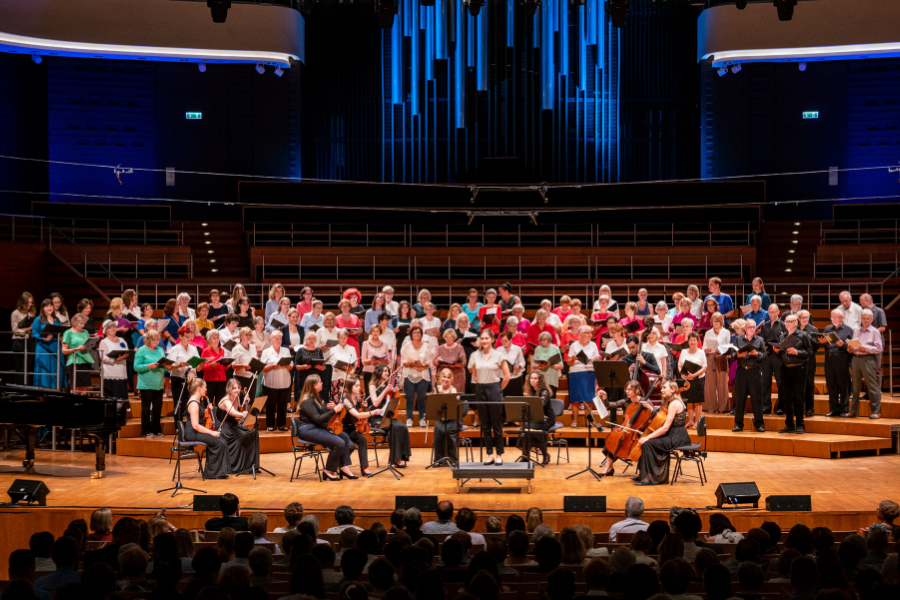Dance of Death
The first album on which the NFM Choir is conducted by Lionel Sow, Artistic Director since 2021. The album was recorded with the participation of Willard White and Jan Krzeszowiec. The theme of the album is danse macabre, and the programme includes the following works: Totentanz op. 12 no. 2 by Hugo Distler, Warum ist das Licht gegeben dem Mühseligen op. 74 no. 1 by Johannes Brahms, Sarabande from Partita in A minor for solo flute BWV 1013 by Johann Sebastian Bach and O Tod, wie bitter bist du op. 110 no. 3 by Max Reger.
Year of release: 2024
Publishers: National Forum of Music, CD Accord
Conductor: Lionel Sow
Performers: Willard White – narrator, Jan Krzeszowiec – flute, NFM Choir
Most of us, when contemplating medieval representations of danse macabre, in which Death leads people of all walks of life, do not pay attention to the sound aspect of the allegory. Yet it is very important – where there is dancing, there must also be music.
In the oldest depictions, dating back to the end of the Middle Ages, it is Death that plays an instrument. Interestingly, it is a wind instrument, such as a flute or bagpipes, or a percussion instrument. In the Middle Ages, such instruments were associated with the devil (the violin is a quite modern attribute in this context). Knowledge of this association has allowed art historians to understand the genealogy of the popular motif. The similarity of the contemporary images of death and the devil (whose domain included such bodily activities as dancing) explains the didactic function of the famous allegory, which appeared in Europe after the plague epidemic in the 14th century.
In the context of numerous painted representations and literary texts of this period, the collection of old musical records referring to the dance of death is relatively modest. 19th-century works such as Totentanz by Ferenc Liszt and Danse macabre by Camille Saint-Saëns have little in common with the classical shape of allegory. Only the times of modernism and the development of historical art sciences meant that composers, exploring old techniques, directly referred to preserved medieval representations. The composers’ imagination was most influenced by paintings from Basel and Lübeck. The Swiss Totentanz inspired Arthur Honegger (La danse des morts) and Frank Martin (Ein Totentanz zu Basel im Jahre 1943), while Hugo Distler paid tribute to the north German one in his work Totentanz, Op. 12 No. 2.
(…) In 1932 at vespers in the Church of St Jakob, whose musical setting Distler was responsible for, there was a performance based on the danse macabre motif – what was played then was the recently discovered Renaissance cycle of motets by Leonhard Lechner, Deutsche Sprüche von Leben und Tod. These works, which are a collection of aphoristic reflections on the nature of transience, made a great impression on Distler. His Totentanz refers to them both in terms of form and compositional technique. In this way, Distler entered an important trend of German historicism. The motet genre was used by, among others, Felix Mendelssohn Bartholdy, Robert Schumann, Johannes Brahms, and Max Reger. The motet was connected with toposes important to the German tradition, as can be seen in the compositions of the latter two.
There is one more piece on this album – Sarabande from Johann Sebastian Bach’s Partita in A minor for solo flute, BWV 1013. It will sound like the lament of Death itself on the ruins of the Lübeck church. For 19th-century German culture, Bach was both the ideal of a romantic artist and at the same time a religious craftsman. The culture founded on similar contradictions gave birth to masterpieces of musical literature, but also to the criminal ideology of Nazism. Each of the above-mentioned composers wanted to equal Bach, and it was Bach who was perceived as a proof of the German people’s superiority. Yet, like them, he was just another human in Death’s procession.
Szymon Atys








